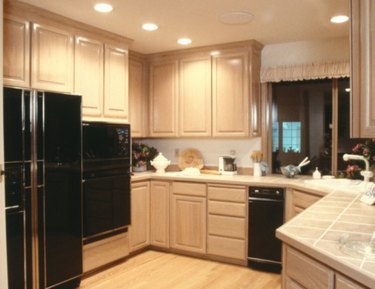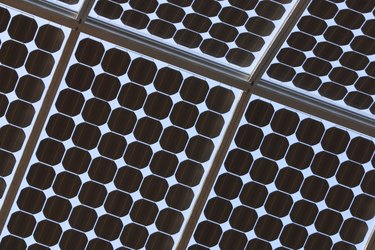The Advantages & Disadvantages of Grid Connected (Grid-tie) Systems
Photovoltaic cells are the main ingredient of all photovoltaic solar energy systems, turning sunlight directly into electricity. Since the first silicon photovoltaic cells were discovered in the 1950s, technological developments have improved performance and transformed solar energy capabilities. An increasingly viable and popular renewable energy source, grid-connected photovoltaic systems grabbed a 75 percent share of U.S. installations in 2009, up from 31 percent in 2001.
Grid Connected Basic Facts

Being grid-connected means that a solar photovoltaic system is linked directly to the available electrical grid or utility lines. A connected system comprises a photovoltaic panel or set of panels that directly convert sunlight into electricity. The size of the system dictates how independent from the grid it’s possible to be. Grid-connected systems need inverters to convert direct current into alternating current usable electricity. The inverter connects to the main electrical supply with a meter showing the number of generated kilowatt hours. Excess electricity can be sold back to the grid.
Constant Reliable Power
Grid-connected photovoltaic systems guarantee a home always has access to power, even if the solar energy fails or is insufficient. The system’s inverter connects to a battery bank that can store energy to be used in a power failure. An advantage of grid-connected systems is that they are not dependent on the sun shining. Off-grid photovoltaic energy is only intermittent but grid-connected systems ensure that any additional electricity needed is automatically delivered by the grid.
Financial Benefits Of Grid Connected Systems
More than 35 states now have “net metering” legislation, meaning that householders benefit from selling excess energy back to the grid at normal retail prices. The Department of Energy notes that this puts people in Hawaii and New York at a great advantage because of the high retail electric rates. State and federal incentives include sales tax exemptions on the systems themselves, property tax exemptions, and personal state income tax credits.
As well to lower energy bills, grid-connected solar systems can add overall value to properties too. A federal study of California homes revealed that a 3,100-kilowatt hour system increases the home’s value by an average of $17,000.
Disadvantages Of Being Grid Connected
Installing solar systems near existing utility power lines means that photovoltaic generated electricity costs more than that supplied by conventional methods. At its cheapest, solar energy is estimated to be 25 cents per kilowatt hour — generally between double and quadruple the cost of utility-supplied electricity. Initial costs are high so in practice installing a grid-connected solar system is like paying your electricity bill up front, years in advance.
The permits and legal requirements for installing grid-connected systems can be costly, complex, and time-consuming. While national standards are beginning to be adopted, many regional agencies have different legislative procedures so the best starting point is the local city or county building department.
- Ashden Awards For Sustainable Energy: Grid Connected Solar Systems
- U.S. Department Of Energy: Solar Energy Resources
- The Solar Guide: Grid Inter-Tied Photovoltaic Systems
- California Solar Center: Solar Evolution
- “Alternative Energy eMagazine”; The US Solar PV Market Analysis Policies and Incentives; Sushmita Chaudhuri
- ABS Alaskan: DC To AC Power Inverters
- “Rutland Herald”; Vermont Owners Of Solar Homes; Bruce Edwards; May 1, 2011

